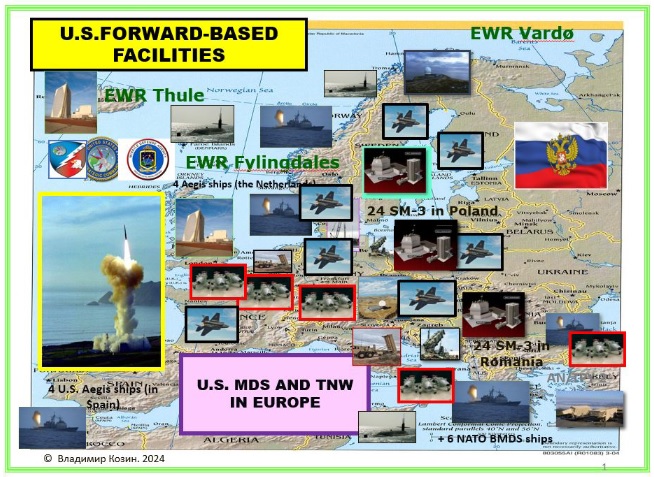
On December 27, 2023, the Bulletin of the Atomic Scientists posted a brief commentary by François Diaz-Maurin, associate editor for nuclear affairs of this edition, entitled "The nuclear year in review: A renewed interest in nuclear weapons – for and against".
In it, he unjustifiably recalled that Russia was allegedly circulating "thinly veiled threats" to use nuclear weapons against Ukraine in 2023. At the same time François Diaz-Morin rightly recognized that this had not been done. To be more precise: no veiled and no overt threats were made at all at the highest state level in Moscow. Nevertheless, the author of the commentary claimed that Russia was allegedly preparing to launch nuclear sabotage at the Zaporozhye nuclear power plant controlled by Russian Armed Forces. But, I wonder: why would they want to do that? To commit a suicide? The associate editor did not elaborate.
But, on the other hand, Francois Diaz-Morin concealed that Ukraine has repeatedly used attack drones, artillery and missile systems against this nuclear power plant with the apparent connivance of the IAEA leadership.
At the same time, the associate editor did not criticize the current U.S. nuclear strategy, which envisages a nuclear first strike against virtually any state in the world, except for the United States' allies and partners, which in recent years have significantly strengthened forward-deployed nuclear missile assets near Russia and the PRC.
In this context, it should be noted that in early December this year in Geneva, the United States tested the SIGNAL game model developed at the request of the Pentagon with the participation of experts from various countries engaged through the United Nations Institute for Disarmament Research or UNIDIR.
It should be taken into account that the SIGNAL model is actually an abbreviation – it is by no means simple, but it is a strategic interaction game between nuclear-armed states, or in English "Strategic Interaction Game Between Nuclear Armed Lands" or SIGNAL for short.
The Russian delegation refused to participate in this dubious spectacle, since the SIGNAL model is designed to study various aspects of conflict escalation within the framework of the American concept of global adaptive and integrated deterrence, including nuclear deterrence.
By conducting such events on international platforms, the U.S. side actually studies approaches and algorithms of nuclear missile strikes that can be delivered against other states.
It was developed by Sandia National Laboratories and the Berkeley University Risk and Security Laboratory (the USA), or "BRSL" for short, at the request of the Pentagon and the United States Department of Energy under the Project “On Nuclear Gaming”. As described by the authors of the model, SIGNAL is a computer operated turn-based strategy board game designed to study the decision-making process on the use of conventional and nuclear weapons in a combination manner. So, is Washington training the world community to be accustomed to the use of nuclear weapons?
It was the SIGNAL game pattern, as follows from the article "Evidence of the unthinkable: experimental wargaming at the nuclear threshold" posted on the BRSL website in October 2022, that was used by the U.S. military lobby to argue for the adoption of U.S. low-yield nuclear warheads having less than 5 kiloton each. Notably, the event with UNIDIR experts was originally announced as "Introduction to wargaming". This compromising title was then changed to "Introduction to peace games". With nuclear weapons’ employment?
During the December 2023 gaming, UNIDIR experts simulated the use of nuclear weapons in combination with general-purpose ground offensives, maritime landings, long-range strike and cyberattacks, as well as the defense of their territory by AAD/MDS. BRSL representatives did not participate in this game, but "monitored the dynamics of the process" and "added it to the statistics". May be useful. By whom? And what for?
It is obvious that by provoking the paralysis of the system of international treaties in the area of reducing the risks of military nuclear threats and withdrawing support from six bilateral and multilateral agreements directly related to nuclear arms control, Washington has simultaneously intensified the elaboration of scenarios of conflicts with the risk of the use of weapons of mass destruction, including nuclear weapons, and large-scale technological disasters. Currently all major United States conventional military exercises end with the use of dummy nuclear weapons. The USA and the UK supply shells fitted with depleted uranium to Ukraine
Given the U.S. concepts of "global multi-domain force dominance" and "first preventive and pre-emptive nuclear strike," the international public and expert community should be especially vigilant and demonstrate an objective perception of the situation by answering the simple question: "Where does the nuclear threat to the world really come from?"
read more in our Telegram-channel https://t.me/The_International_Affairs

 10:53 05.01.2024 •
10:53 05.01.2024 •






















